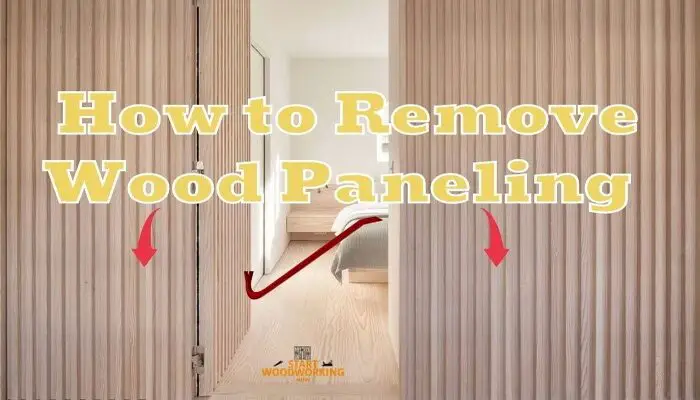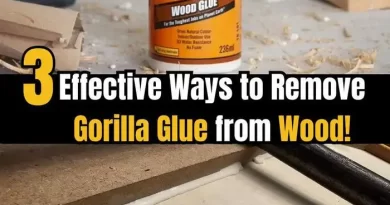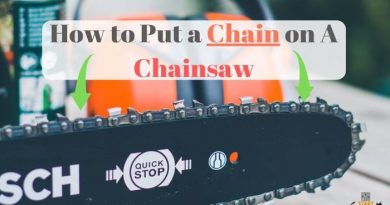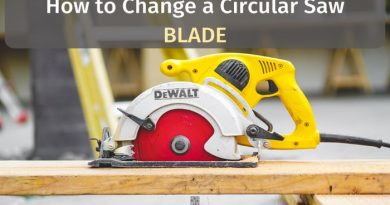How To Remove Wood Paneling In 6 Easy Steps
Removing old wood paneling can be a lot of work, especially if the wood panels are already damaged. In the following step-by-step instructions , we will therefore show you how you can skillfully remove wood paneling from ceilings or walls in just a few steps and what you should definitely pay attention to when removing.
One thing in advance: the removal of wood paneling usually leaves slight traces, be it glue residue, holes from nails or screws or slight cracks in the plaster.
The trick is therefore to remove a wooden paneling with as little residue as possible and without lasting damage to the surface. Only if this is the case can fast and cost-efficient post-processing of the substrate be made possible.
How To Remove Wood Paneling
- Remove the moldings and trims from the wood panels.
- Then, use a crowbar and hammer to remove door and window frames, baseboards and any other type of framing over the wood panels.
- Insert the crowbar into a corner of the wood panels and start removing them. If they are just nailed in place, they should easily come off that way. However, they may also have been glued to the drywall, leaving the remaining adhesive on the wall.
- Heat the glue over the drywall with a hot air gun or hair dryer; the heat will soften the adhesive, making it easier to scrape off. Use a putty knife to remove the heated glue from the wall.
- Apply drywall plaster to the nail holes in the wall. Use a putty knife to carefully spread the putty into the holes and any grooves created by removing the adhesive. Let the putty dry according to the manufacturer’s instructions.
- Sand the plaster with fine-grit sandpaper and finally paint the walls when they are smooth.
Below you will find a brief overview of the tools that you need for the residue-free removal of wood paneling on walls or ceilings. If necessary, you can also borrow these conveniently from a hardware store or from a tool rental shop.
Tools to remove wood paneling
If you need help with the disposal of old wooden panels or have questions about the correct disposal, we are of course at your disposal.
Removing the old wooden paneling is very easy with a few tools:
Tools to remove wood paneling |
|---|
| 1. Crowbar: You can use this tool to generate very good leverage. |
| 2. Screwdriver (preferably with a striking cap) and hammer: this way you can easily loosen supporting ceiling moldings so that you can remove the panels from the wooden ceiling without much effort. |
| 3.Spatula: A spatula is useful in places where the chisel is too massive, but the screwdriver is too small. In the case of glued ceilings, the spatula will also help you remove the adhesive residue. |
| 4.Cordless screwdrivers : Most substructures are attached with screws, so it would take you far too long to loosen 50 or more screws by hand. |
| 5.Ladder: Make sure that the ladder has a solid surface, as you have to work with a lot of force depending on the ceiling. |
How To Remove Wood Paneling Step by Step
TOOLS FOR REMOVING WOODEN PANELS
- Pry / crowbar
- Spatula / chisel
- Screwdriver
- Pliers
Step 1 :Remove the baseboards and wall strips
Before you can start removing the actual wood paneling, you must first remove all baseboards covers and wall strips. This works best with a pry or crowbar. To do this, slide the tool under the wood panel or strip and carefully lift it up. The bar can now easily be released from the anchorage.
Step 2 :Determine the type of fastening of the wooden panels
After the first strip or cover has been removed, you can now see how the individual wood panels are attached to the substructure. Most wall or wooden ceiling panels are nailed, screwed or glued.
If you cannot see any nail or screw heads, it is very likely that it is glued wood paneling.
Here is an easy step by step tutorial how to remove nails from wood without much effort!
Step 3 :Remove the wood paneling
Nailed wood panels can usually be loosened relatively easily and without great effort using a crowbar and then loosened. Screwed plates can also usually be removed quickly and easily using an electric screwdriver.
Glued boards, on the other hand, are usually a major obstacle. Because when the wood panels are torn out, old cement plaster often sticks to the wood.
In order to detach glued panels from the substrate, you should preferably work with a spatula or a chisel. To do this, move the tool under the panel, lift it up and remove it.
Depending on how strongly the paneling is glued, removing it can be hard work and a real challenge. If the wood cladding can only be loosened with great effort or with lasting damage to the wall, we recommend that you consult trained professionals. Even with integrated ceiling lighting, if in doubt, you should instruct a specialist to dismantle the wooden ceiling panels.
If you want to know the best methods to remove glue from wood check this simple guide!
Step 4 :Remove the substructure from wall
Once the wood paneling on the wall and ceiling has been loosened, it is time to remove the substructure. The substructure of a wooden panel is usually screwed directly to the wall.
In order not to unnecessarily enlarge the holes in the wall or ceiling, you should always unscrew screws and never pull them out or break them. Dowels should also be removed as gently as possible.
Only after the entire substructure has been loosened can you take care of any stuck dowels. To do this, screw a screw halfway into the dowel and then carefully pull both out of the wall.
Be careful in old buildings: If the wall plaster is crumbly, you should leave the substructure in place. Instead, you can cover these with plasterboard or so-called counter battens. Or maybe you opt for new wood cladding with durable waterproofing.
Step 5 :Refurbish Damaged Walls or Ceilings
Before you apply new wallpaper or paint to your now bare walls, you should first prepare them thoroughly. To do this, clean the surface with a brush and remove all loose plastering parts.
Any gaps and drill holes that have arisen can be repaired with mortar or filler. You can find our practical guide on how to close or repair old drill holes here.
You can then use adhesive plaster and a finishing trowel to restore a smooth surface. After applying an appropriate primer, you can design your walls again according to your ideas.
Step 6 :Dispose of the Old Wood Paneling
Last but not least, the old paneling and wood scraps still have to be disposed of properly. While untreated wood can be thrown into the bulky waste, wood with glue residues or the like must be disposed of separately.
Here is an entire guide on how to easily remove wooden dowels and prevent it from broken off!
But be careful! It is not always the removal of old panels without problems. These difficulties could occur at work:
| Difficulty | Solution |
|---|---|
| Integrated ceiling lighting | Disassemble by a specialist |
| Old insulation materials under the panels | If in doubt, ask the specialist to examine the toxins |
| No screws to see, but panels not glued | Release the panels from the claws of the profile board |
| Crumbling wall or ceiling behind the panels | Cover with a plasterboard, rebuild the walls |
How To Remove Wood Paneling from Walls
Removing wood panels from the wall is a simple procedure, as long as you have the correct tools and instructions
Giving a room a new look or removing a damaged section are two reasons why removing wall panels would be necessary. After you have removed the wall covering, you will have the freedom to change the look of the room to almost anything you want.
Steps to follow to remove wood paneling from walls:
Step1. Loosen the base plate and crown molding with a screwdriver. Once they have been loosened, carefully remove both the base plate and crown molding. Try not to hit or while taking off because you will most likely need it in the future.
Step2. Remove any screws or nails from the panels with a pry bar. Look carefully to make sure you remove any obstacles you may get in the way of proceeding. You can also use a screwdriver or tweezers when necessary.
Step3. Place a chisel against the wood paneling, and start to split. Start at the top, and proceed with caution. Your time will vary in this step, depending on the number of panels you have.
Step 4. Use a putty knife to remove any glue that remains. Your goal is to separate the paneling from all the glue and nails that may be holding it against the wall.
Step 5. Take a crowbar and separate all the remaining panels. Now all the bonds must be broken, and you can complete the elimination process. Be careful because the wall panels can have nails or sharp edges. You can now hang new panels or choose wallpaper or wall paint instead.
How To Remove Wood Paneling from Drywalls
1. Remove wall strips
First, you should remove the end strips with a crowbar. If you don’t know how each board of the cladding was attached, you can now look into the gap with a flashlight.
Starting at the edge of the paneling, use the crowbar to remove the trim. You should now be able to see how the panels were attached. Unscrew screws or loosen the nails with the crowbar.
2. Remove the wood panels
You have a problem when the panels are glued to the wall. The old cement plaster will then probably say goodbye with the panels. However, if the panels are nailed , you can remove them with the crowbar. If possible, always work along the substructure so that the wall is damaged as little as possible.
Work your way up systematically, wood panel by wood panel. Use the substructure as a guide to find out where the next screws or nails are. With glued panels, you need to be careful not to damage the wall too much.
3. Unscrew the substructure
The substructure is usually screwed. You should unscrew the screws, not break them. Then you can turn a screw a little bit into each dowel and then pull the dowel out at this screw.
This way the dowel does not tear even larger holes in the wall. Usually the slats of the substructure are screwed. Carefully remove these screws so as not to tear the wall plugs unnecessarily and damage them.
4. Repair the drywall
You can close a few small dowel holes with a little plaster of filler. However, if the old wood paneling has caused major damage, you will have to remove the remaining loose plaster for better or worse.
After you’ve removed all of the panels and sub-frame slats, you can get down to repairing the wall. You can fill smaller dowel holes with filler. However, if the wall shows major damage, you must first remove any loose plaster.
Then the surface is pretreated with an adhesive or deep primer. You can then repair the surface with the trowel and some cement plaster. Smooth out the plaster with the sponge board.
How to Remove Wood Paneling without Damaging it
What you need:
- Chisels
- Filler
- Adhesive plaster
- Sponge board
- Smoothing trowel
- Primer / primer
Here are the steps to remove wood paneling without damaging it:
- First remove the covers or end strips. Use a crowbar or chisel.
- Slide this under the first panel, lift the plate and remove it from its anchorage.
- Now look to see how the wood cladding is attached to the substructure. It can be glued, screwed or nailed. While you can easily remove nails and screws, the glue usually causes problems.
- Check whether you can peel off the glued panels without damaging them. If this is not possible, you should seek advice from a professional.
- Decorative cladding usually works with a tongue and groove system.
- When you have removed the first plate, you can carefully pull out the next one as well.
- To reuse the paneling, you should be careful not to damage or bend the brackets.
- What remains is the substructure that is connected to the wall. If you have the impression that the substance is by and large in order, you can also remove this slat construction.
- In old buildings or with very crumbly plaster, it is often better to leave the substructure in place.
- You could now attach plasterboard to it with counter battens or opt for a new wooden cladding to suit your taste.
Filling dowel holes in wood can be a very easy job if you follow this step by step guide!
Conclusions
DISMANTLING WOODEN PANELS – A JOB THAT SHOULD NOT BE UNDERESTIMATED
As can be seen from the above step-by-step instructions, removing wooden panels and cladding on walls and ceilings is not a DIY project that should be taken too lightly. Glued wood paneling in particular harbors risks and should therefore always be removed with care in order to avoid major damage to the sub-floor plaster.
Is it hard to remove a wooden paneling?
Most wooden ceilings have panels attached to a substructure. With a little skill, you can remove the entire wood paneling in a room in one to two hours.
Do I have to remove any adhesive residue before re-plastering?
Yes, because these affect liability. In the case of very solid connections with glued wooden ceilings, the question arises whether you are building a structure under the wooden ceiling.




